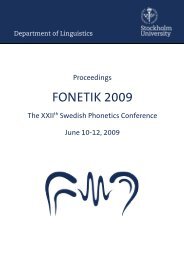The Double Passive in Swedish - Institutionen för lingvistik ...
The Double Passive in Swedish - Institutionen för lingvistik ...
The Double Passive in Swedish - Institutionen för lingvistik ...
You also want an ePaper? Increase the reach of your titles
YUMPU automatically turns print PDFs into web optimized ePapers that Google loves.
complement <strong>in</strong> the <strong>Double</strong> <strong>Passive</strong> surfaces as an s-passive <strong>in</strong>f<strong>in</strong>itive verb – whereas <strong>in</strong> the Complex<br />
<strong>Passive</strong>, the verbal complement must surface as an embedded participle.<br />
Example (20) shows the matrix verb ‘planera’ (‘plan’) <strong>in</strong> an active construction.<br />
(20) Jane planera-r att reparera bilen.<br />
Jane plan-PRS to repair:INF car-the.<br />
‘Jane plans to repair the car.<br />
When the verb is passivized as <strong>in</strong> (21a-c) two different k<strong>in</strong>ds of passives are observed. <strong>The</strong> first k<strong>in</strong>d<br />
<strong>in</strong> (21a) and (21b), follows the pattern of passivization of transitive verbs – the whole <strong>in</strong>f<strong>in</strong>itival<br />
complement raises to subject (the personal passive), or the <strong>in</strong>f<strong>in</strong>itival complement reta<strong>in</strong>s its<br />
grammatical function and the passive matrix verb occurs with an expletive ‘det’ (‘there’) (Ørsnes,<br />
2006:387). <strong>The</strong> second k<strong>in</strong>d, a <strong>Double</strong> passive, is shown <strong>in</strong> (21c) – where the <strong>in</strong>ternal argument ’bilen’<br />
of the embedded verb is raised to subject of the passive matrix verb. <strong>The</strong> verb <strong>in</strong> the <strong>in</strong>f<strong>in</strong>itival<br />
complement surfaces as an s-passive <strong>in</strong>f<strong>in</strong>itive, and the agent is non-overt by option (Ørsnes,<br />
2006:387).<br />
(21) a) Att reparera bilen planera-s.<br />
To:COMP repair:INF car:the plan:INF-PASS<br />
‘To repair the car is be<strong>in</strong>g planned.<br />
b) Det planera-s att reparera bilen.<br />
It plan-PASS to:COMP repair:INF car:the.<br />
‘It’s be<strong>in</strong>g planned to repair the car.<br />
c) Bilen planera-s att reparera-s.<br />
Car:the plan-PASS to:COMP repair:INF-PASS<br />
‘As for the car it is be<strong>in</strong>g planned to be repaired.’<br />
Further on <strong>in</strong> this thesis, solely the <strong>Double</strong> <strong>Passive</strong> <strong>in</strong> <strong>Swedish</strong> formed with two s-passives will be<br />
studied and referred to.<br />
2.6 Restrictions on the <strong>Double</strong> <strong>Passive</strong><br />
Identify<strong>in</strong>g the <strong>Double</strong> <strong>Passive</strong> can be difficult <strong>in</strong> some cases. In the sections (2.6) and (2.7), the<br />
constructions and verbs that cannot occur <strong>in</strong> a <strong>Double</strong> <strong>Passive</strong> are shown accord<strong>in</strong>g to the literature.<br />
2.6.1 Expletive SUBJ and extra PREP<br />
<strong>The</strong> matrix verbs <strong>in</strong> the active control construction do not allow expletive (non-thematic) subjects<br />
(Ørsnes, 2006:391), as shown <strong>in</strong> (22a-b).<br />
18

















